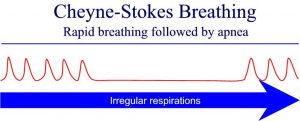W.B.C.S. Examination Notes On – Cheyne Stokes Breathing – Animal Husbandry And Veterinary Sciences Notes.
Cheyne Stokes breathing is a type of abnormal breathing. It’s characterized by a gradual increase in breathing, and then a decrease. This pattern is followed by a period of apnea where breathing temporarily stops. The cycle then repeats itself.Continue Reading W.B.C.S. Examination Notes On – Cheyne Stokes Breathing – Animal Husbandry And Veterinary Sciences Notes.
When does it most likely occur?
According to research, Cheyne Strokes breathing can happen while you’re awake, but is more common during sleep. It may happen more during non-rapid eye movement (NREM) sleep than rapid eye movement (REM) sleep.
When Cheyne Stokes occurs during sleep, it’s considered a form of central sleep apnea with an extended period of fast breathing (hyperventilation). Central sleep apnea causes you to stop breathing briefly and increases the levels of carbon dioxide in your body.
Cheyne Stokes is usually related to heart failure or stroke. It may also be caused by:
- brain tumors
- traumatic brain injuries
- high altitude sickness
- encephalitis
- increased intercranial pressure
- chronic pulmonary edema
People who are dying often experience Cheyne Stokes breathing. This is a natural effect of the body’s attempt to compensate for changing carbon dioxide levels. While it may be distressing to those who witness it, there’s no evidence Cheyne Stokes is stressful for the person experiencing it.
Both Kussmaul breathing and Cheyne Stokes breathing are characterized by fast breathing and too much carbon dioxide in the body, but that’s where their similarities end. Kussmaul breathing doesn’t alternate between fast and slow breathing or cause breathing to stop like Cheyne Stokes does. Instead, it’s characterized by a deep, rapid breathing pace throughout its duration.
Kussmaul breathing is often caused by late-stage diabetic ketoacidosis. Diabetic ketoacidosis is a metabolic condition caused by a lack of insulin and too much glucagon in the body. Glucagon is a hormone produced by the pancreas that increases blood sugar. Kussmaul breathing may also be present in people with kidney failure.
Other types of abnormal respiration cause fast or slow breathing, such as:
Hyperventilation
When someone breathes deeply and too fast, it’s called hyperventilation. It leads to elevated levels of oxygen and low levels of carbon dioxide in the blood. The condition is often caused by anxiety, stress, or a panic attack. It may also be caused by excessive bleeding, heart disease, or a lung disease such as asthma.
Left unchecked, hyperventilation may cause:
- dizziness
- lightheadedness
- fainting
- weakness
- confusion
- numbness in your arms or mouth
- muscle spasms
- chest pain
- fast heart rate
Hypoventilation
When someone breathes too slowly or too shallowly, it’s called hypoventilation. It leads to low oxygen levels and high levels of carbon dioxide in the blood. Hypoventilation may be caused by lung problems that obstruct the lower airways, such as emphysema, cystic fibrosis, or bronchitis.
Symptoms of hypoventilation may include:
- heart problems
- being sleepy during the day
- stomach problems
- headaches
- fainting
Obstructive sleep apnea
This condition causes you to stop breathing for 10 seconds or more while you sleep. Although everyone’s breathing pauses occasionally during sleep, people with obstructive sleep apnea stop breathing at least five times per hour. In severe cases, people may stop breathing every minute.
Obstructive sleep apnea can happen to anyone, but it’s most common in people who are obese. Symptoms may include:
- daytime sleepiness
- waking up short of breath
- morning headaches
- mood changes
- difficulty concentrating
Sleep apnea is treated with CPAP therapy and lifestyle changes such as weight loss. Left untreated, obstructive sleep apnea may lead to heart problems, and even death.
Please subscribe here to get all future updates on this post/page/category/website


 +919674493673
+919674493673  mailus@wbcsmadeeasy.in
mailus@wbcsmadeeasy.in







































































































